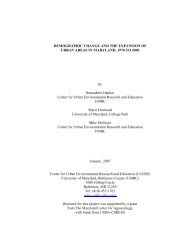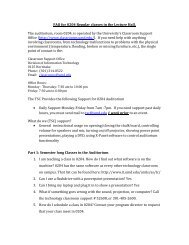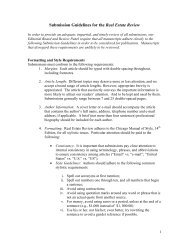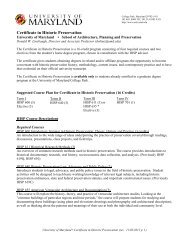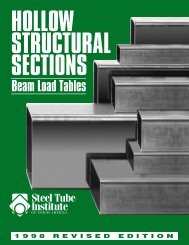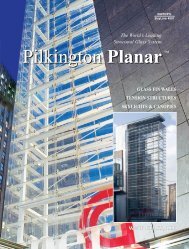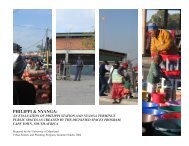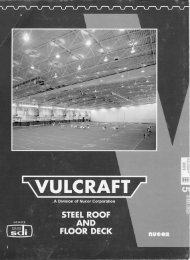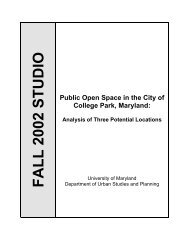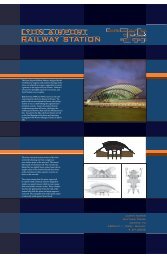Vulcraft_Joist_Catal..
Vulcraft_Joist_Catal..
Vulcraft_Joist_Catal..
- No tags were found...
Create successful ePaper yourself
Turn your PDF publications into a flip-book with our unique Google optimized e-Paper software.
LONGSPAN AND DEEP LONGSPAN STEEL JOISTS, LH- AND DLH-SERIES<br />
3) Weld Inspection by Outside Agencies (See Section<br />
104.13 of these specifications).<br />
The agency shall arrange for visual inspection to<br />
determine that welds meet the acceptance standards<br />
of Section 103.5(a)(1) above. Ultrasonic,<br />
X-Ray, and magnetic particle testing are inappropriate<br />
for joists due to the configurations of the<br />
components and welds.<br />
(b) Strength<br />
Joint connections shall develop the maximum force<br />
due to any of the design loads, but not less than 50<br />
percent of the allowable strength of the member in<br />
tension or compression, whichever force is the controlling<br />
factor in the selection of the member.<br />
(c) Shop Splices<br />
Shop splices may occur at any point in chord or web<br />
members. Splices shall be designed for the member<br />
force but not less than 50 percent of the allowable<br />
member strength. Members containing a butt weld<br />
splice shall develop an ultimate tensile force of at<br />
least 57 ksi (393 MPa) times the full design area of<br />
the chord or web. The term “member” shall be<br />
defined as all component parts comprising the chord<br />
or web, at the point of splice.<br />
(d) Field Splices<br />
Field Splices shall be designed by the manufacturer<br />
and may be either bolted or welded. Splices shall be<br />
designed for the member force, but not less than 50<br />
percent of the allowable member strength.<br />
103.6 CAMBER<br />
<strong>Joist</strong>s shall have approximate cambers in accordance<br />
with the following:<br />
Top Chord Length Approximate Camber<br />
20'-0" (6096 mm) ¹⁄₄" (6mm)<br />
30'-0" (9144 mm) ³⁄₈" (10 mm)<br />
40'-0" (12192 mm) ⁵⁄₈" (16 mm)<br />
50'-0" (15240 mm) 1" (25 mm)<br />
60'-0" (18288 mm) 1¹⁄₂" (38 mm)<br />
70'-0" (21336 mm) 2" (51 mm)<br />
80'-0" (24384 mm) 2³⁄₄" (70 mm)<br />
90'-0" (27432 mm) 3¹⁄₂" (89 mm)<br />
100'-0" (30480 mm) 4¹⁄₄" (108 mm)<br />
110'-0" (33528 mm) 5" (127 mm)<br />
120'-0" (36576 mm) 6" (152 mm)<br />
130-0" (39621 mm) 7" (178 mm)<br />
140'-0" (42672 mm) 8" (203 mm)<br />
144'-0" (43890 mm) 8¹⁄₂" (216 mm)<br />
The specifying professional shall give due consideration<br />
to coordinating joist camber with adjacent framing.<br />
103.7 VERIFICATION OF DESIGN AND<br />
MANUFACTURE<br />
(a) Design Calculations<br />
Companies manufacturing any LH- or DLH-Series<br />
<strong>Joist</strong>s shall submit design data to the Steel <strong>Joist</strong> Institute<br />
(or an independent agency approved by the Steel<br />
<strong>Joist</strong> Institute) for verification of compliance with the SJI<br />
Specifications.<br />
(d) In-Plant Inspections<br />
Each manufacturer shall verify his ability to manufacture<br />
LH- and DLH-Series <strong>Joist</strong>s through periodic<br />
In-Plant Inspections. Inspections shall be performed by<br />
an independent agency approved by the Steel <strong>Joist</strong><br />
Institute. The frequency, manner of inspection, and<br />
manner of reporting shall be determined by the Steel<br />
<strong>Joist</strong> Institute. The plant inspections are not a guaranty<br />
of the quality of any specific joists; this responsibility<br />
lies fully and solely with the individual manufacturer.<br />
SECTION 104.<br />
APPLICATION<br />
104.1 USAGE<br />
These specifications shall apply to any type of structure<br />
where floors and roofs are to be supported directly by steel<br />
joists installed as hereinafter specified. Where joists are<br />
used other than on simple spans under uniformly distributed<br />
loading as prescribed in Section 103.1, they shall be<br />
investigated and modified if necessary to limit the unit<br />
stresses to those listed in Section 103.2.<br />
CAUTION: If a rigid connection of the bottom chord is to be<br />
made to the column or other support, it shall be made only<br />
after the application of the dead loads. The joist is then no<br />
longer simply supported, and the system must be investigated<br />
for continuous frame action by the specifying professional.<br />
The designed detail of a rigid type connection and moment<br />
plates shall be shown on the structural drawings by the<br />
specifying professional. The moment plates shall be furnished<br />
by other than the joist manufacturer.<br />
104.2 SPAN<br />
The clear span of a joist shall not exceed 24 times its depth.<br />
The term “Span” as used herein is defined as the clear span<br />
plus 8 inches (203mm).<br />
104.3 DEPTH<br />
The nominal depth of pitched chord joists shall be the depth<br />
at mid-span. The standard slope of the top chord shall be ¹⁄₈<br />
inch per foot (1:96).<br />
104.4 END SUPPORTS<br />
(a) Masonry and Concrete<br />
LH- and DLH-Series <strong>Joist</strong>s supported by masonry or<br />
concrete are to bear on steel bearing plates and shall<br />
be designed as steel bearing. Due consideration of the<br />
end reactions and all other vertical and lateral forces<br />
shall be taken by the specifying professional in the<br />
design of the steel bearing plate and the masonry or<br />
concrete. The ends of LH- and DLH-Series <strong>Joist</strong>s shall<br />
extend a distance of not less than 6 inches (152 mm)<br />
over the masonry or concrete support and be<br />
59



